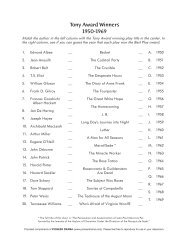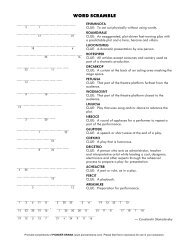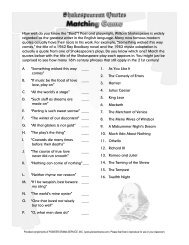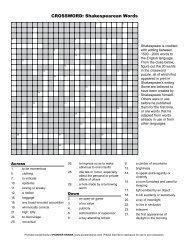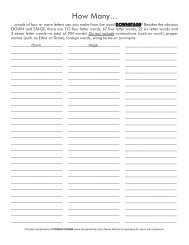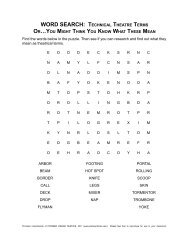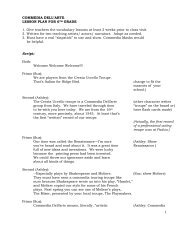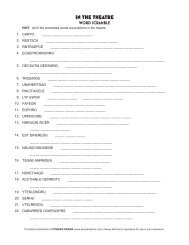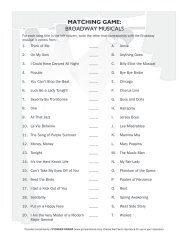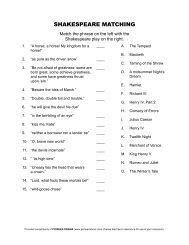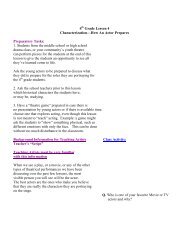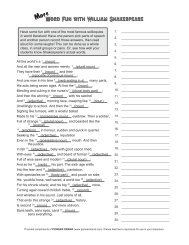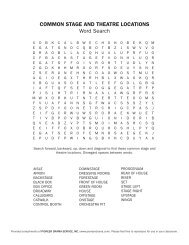You also want an ePaper? Increase the reach of your titles
YUMPU automatically turns print PDFs into web optimized ePapers that Google loves.
<strong>How</strong> <strong>Well</strong> <strong>Do</strong> <strong>You</strong> <strong>Know</strong> <strong>Theatre</strong>?<br />
<strong>Part</strong> Two<br />
ANSWER KEY<br />
1. The director tells you that the play will be<br />
performed in a black box theatre. This is:<br />
c. a neutral performance space in<br />
which the audience and performance<br />
area can be arranged in a variety of<br />
configurations<br />
This type of theatre differs from the<br />
traditional proscenium stage, which<br />
has permanent seating, a raised stage,<br />
possibly an orchestra pit and wings.<br />
The black box theatre is ideal for lowbudget,<br />
experimental or non-traditional<br />
plays, usually employing minimal<br />
scenery and seating fewer than 100<br />
people. The space usually has its walls<br />
painted black.<br />
2. <strong>You</strong> are building a flat for the set. A flat is:<br />
b. a wooden frame covered in canvas to<br />
form walls<br />
Flats can also have openings to fit a<br />
door frame or window.<br />
3. If you are told to place the lights and<br />
speakers in the front of house (FOH), you<br />
are installing them:<br />
e. in the audience area<br />
4. A couch needs to be set upstage left. <strong>You</strong><br />
put it:<br />
d. to the rear of the stage on the audience’s<br />
right<br />
The stage is often divided into fifteen<br />
convenient areas around which a<br />
director can block movement and place<br />
furniture, scenery, etc. C=center, R=right,<br />
L=left, D=down, U=up. Right and left<br />
are defined from the actor’s perspective,<br />
looking out at the audience, up is<br />
farthest from the audience, while down<br />
is closest to the audience.<br />
5. A thrust stage has audience seated:<br />
a. on three sides of the stage<br />
6. Footlights are located:<br />
e. b or d<br />
Depending on the configuration of the<br />
theatre, the trough might be in front of<br />
the apron or on the stage floor.<br />
7. If your stage direction is to “close the<br />
shutters” you are:<br />
d. part of the lighting crew<br />
The shutters are devices that reduce the<br />
area of light beams in Fresnel lights and<br />
spotlights.<br />
8. The tech meeting is scheduled in the booth,<br />
which is:<br />
a. located at the back of the audience<br />
The booth is the small isolated room<br />
in which the electrician and/or sound<br />
technician sits to operate the lights,<br />
sound and other effects. It is usually<br />
located in the rear of the theatre behind<br />
the audience. Also called a sound booth,<br />
light booth or projection booth.<br />
9. If your sound system is giving feedback, it<br />
is:<br />
c. producing a loud whistling noise<br />
Feedback is the sound from a<br />
loudspeaker to a microphone which<br />
results in a whistling noise caused by<br />
electrical oscillations.<br />
10. Some of the seats in the theatre have been<br />
reduced in price due to their poor sight line.<br />
This means the seats:<br />
b. have a restricted view of the playing<br />
area onstage<br />
A sight line is the range of vision from<br />
the audience to the stage. Ideally, every<br />
seat in the house should provide an<br />
unrestricted view of the playing area,<br />
while obscuring the view to backstage.<br />
Curtains and set pieces are used to<br />
direct the audience’s view, although<br />
the architecture of the theatre plays an<br />
important part in establishing sight lines<br />
as well.<br />
Provided compliments of PIONEER DRAMA (www.pioneerdrama.com) Please feel free to reproduce for use in your classroom.



